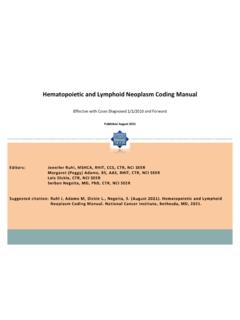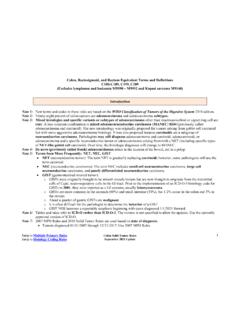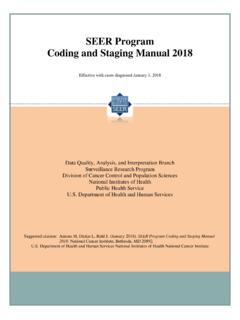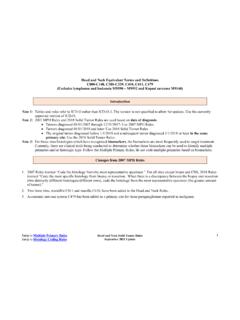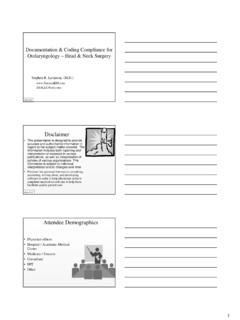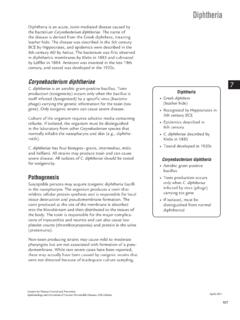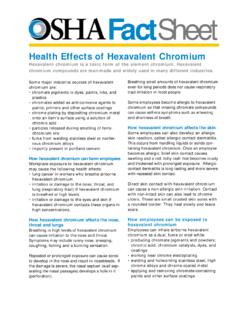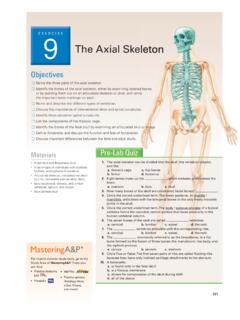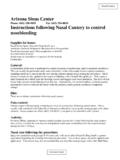Transcription of ORAL CAVITY AND ORAL PHARYNX
1 DEFINITION OF ANATOMIC SITES WITHIN THE HEAD AND NECK. adapted from the Summary Staging Guide 1977 published by the SEER Program, and the AJCC Cancer Staging Manual Fifth Edition published by the American Joint Committee on Cancer Staging. Note: Not all sites in the lip, oral CAVITY , PHARYNX and salivary glands are listed below. All sites to which a Summary Stage scheme applies are listed at the begining of the scheme. oral CAVITY AND oral PHARYNX (in ICD-O-3 sequence). The oral CAVITY extends from the skin-vermilion junction of the lips to the junction of the hard and soft palate above and to the line of circumvallate papillae below. The oral PHARYNX (oropharynx) is that portion of the continuity of the PHARYNX extending from the plane of the inferior surface of the soft palate to the plane of the superior surface of the hyoid bone (or floor of the vallecula) and includes the base of tongue, inferior surface of the soft palate and the uvula, the anterior and posterior tonsillar pillars, the glossotonsillar sulci, the pharyngeal tonsils, and the lateral and posterior walls.
2 The oral CAVITY and oral PHARYNX are divided into the following specific areas: LIPS ( ; vermilion surface, mucosal lip, labial mucosa) upper and lower, form the upper and lower anterior wall of the oral CAVITY . They consist of an exposed surface of modified epider- mis beginning at the junction of the vermilion border with the skin and including only the vermilion surface or that portion of the lip that comes into contact with the opposing lip. The lips extend from commissure to commissure and, for SEER Summary Stage include the mucous membrane lining the inner surface of the lips (labial mucosa). For AJCC, the labial mucosa is included with buccal CAVITY in the oral CAVITY staging scheme. COMMISSURE OF. LIP ( ; corner of mouth) is the point of union of upper and lower lips and is considered part of the lip. BASE OF. TONGUE ( ; base of tongue, root of tongue) consists of the less mobile portion of the tongue which extends inferiorly from the line of circumvallate papillae to the base of the epiglottis, the pharyngoepiglottic and glossoepiglottic folds (which bound the vallecula).
3 The posterior one- third of tongue is part of the oropharynx in the AJCC staging system. ANTERIOR 2/3 OF. TONGUE ( ; mobile or oral tongue) consists of the freely movable portion of the tongue which extends anteriorly from the line of circumvallate papillae to the root of the tongue at the junction of the floor of the mouth. It is composed of four areas: tip, lateral borders, dorsum, and undersurface or ventral surface (non-villous surface). The anterior two-thirds of tongue is part of the oral CAVITY in the AJCC staging system. LINGUAL. TONSIL ( ) the lymphoid tissue that is contained in the base of the tongue. In the Summary Stage system, lingual tonsil is coded using the same scheme as base of tongue; in the AJCC system it is included in the oropharynx scheme. 16 SEER Summary Staging Manual - 2000. UPPER. GUM ( ; upper alveolar ridge) is the covering mucosa of the alveolar process of the maxilla, extending from the line of attachment of mucosa in the upper gingival buccal gutter to the junction of the hard palate.
4 Its posterior margin is the upper end of the pterygopalatine arch. The gingiva is part of the oral CAVITY in the AJCC staging system. LOWER. GUM ( ; lower alveolar ridge) includes the alveolar process of the mandible and its covering mucosa, which extends from the line of attachment of mucosa in the buccal gutter to the line of free mucosa of the floor of the mouth. Posteriorly it extends to the ascending ramus of the mandible (see retromolar trigone). The gingiva is part of the AJCC oral CAVITY staging system. FLOOR OF. MOUTH ( ) consists of a semilunar shaped space over the mylohyoid and hypoglossus muscles, extending from the inner surface of the lower alveolar ridge to the undersurface of the tongue. Its posterior boundary is the base of the anterior pillar of the tonsil. It is divided into two sides by the frenulum of the tongue and contains the ostia of the submaxillary and lingual salivary glands.
5 The floor of mouth is part of the AJCC oral CAVITY staging system. HARD. PALATE ( ) consists of the semilunar area between the upper alveolar ridges and the mucous membrane covering the palatine process of maxillary palatine bones. It extends from the inner surface of the superior alveolar ridge to the posterior edge of the palatine bone. In the TNM. system, the hard palate is part of the oral CAVITY staging scheme. SOFT. PALATE ( ) consists of mucosa covering the oral CAVITY side of the palatine muscles and extends from the posterior edge of the hard palate to the free border of the soft palate and includes the uvula. Its superior lateral margin is the pterygomandibular raphe. The inferior lateral margin completes the faucial arch (glossopalatine arch) and includes the anterior surface of the of the anterior tonsillar pillar. In the AJCC system, the soft palate is part of the oropharynx staging system.
6 UVULA ( ) is a soft tissue projection on the free border of the soft palate in the midline of the body. In Summary Stage, the uvula is coded using the same scheme as the soft palate. In the AJCC system, the uvula is part of the oropharynx staging system. OTHER. MOUTH ( , ) includes overlapping lesions of the palate, overlapping lesions of other and unspecified parts of mouth, and non-specific terms roof of mouth (palate, NOS);. mouth, NOS ( oral CAVITY , oral mucosa, buccal CAVITY ); and minor salivary gland, NOS. All of these non-specific sites are included in the oral CAVITY scheme of the AJCC staging system. CHEEK. MUCOSA ( ) includes all the mucous membrane lining the inner surface of the cheek. In ICD-O-3. and the Summary Stage system, buccal mucosa includes the inner surface of the cheeks but not the inner mucosal surface of the lips.
7 In the AJCC staging system, the inner mucosa of the lips is included with the buccal mucosa in the oral CAVITY scheme. SEER Summary Staging Manual - 2000 17. VESTIBULE OF. MOUTH ( ; buccal sulcus, alveolar sulcus, labial sulcus) the space between the teeth and the lips or cheeks and the mucosa that covers it. In the Summary Stage system, the vestibule of mouth is included in the coding scheme for cheek (buccal) mucosa; in the AJCC staging system, it is included in the oral CAVITY scheme. RETROMOLAR. AREA ( ; retromolar triangle, retromolar gingiva, retromolar area) the attached mucosa overly- ing the ascending ramus of the mandible from the level of the posterior surface of the last molar tooth to the apex superiorly. The retromolar trigone is coded using the same Summary Stage scheme as the gingiva or gums. It is part of the oral CAVITY staging scheme in the AJCC.
8 System. TONSILS are the mucosa-covered lymphoid tissues lying between the palatoglossal and palatopharngeal arches on the sidewalls of the oropharynx (palatine tonsils, ), on the posterior wall of the nasopharynx (pharyngeal tonsils or adenoids ( ) and embedded in the base of the tongue (lingual tonsil, ; described above). These three areas appear to form a ring of lymphoid tissue around the PHARYNX , which is referred to as Waldeyer's ring ( ). PAROTID GLAND AND OTHER MAJOR SALIVARY GLANDS. The parotid glands ( ) and the other major salivary glands, submandibular (submaxillary) ( ). and sublingual/submental ( ) are paired glands lying along the mandible and beneath the floor of the mouth which produce serous or mucous secretions to moisten the mouth and begin the process of diges- tion. OROPHARYNX. ANTERIOR. WALL consists of the pharyngoepiglottic and glossoepiglottic folds which bound the vallecula ( ), and the lingual (anterior) surface of the epiglottis ( ).)
9 The vallecula is the hollow or sulcus formed at the junction of the base of the tongue and the epiglottis. LATERAL. WALL ( ) includes the tonsillar pillars ( ), tonsillar fossae ( ), and tonsils ( ) of the oropharynx. POSTERIOR. WALL ( ) extends from the free borders of the soft palate to the tip of the epiglottis in the oropharynx. 18 SEER Summary Staging Manual - 2000. NASOPHARYNX. The nasopharynx begins anteriorly at the posterior choana and extends along the plane of the airway to the level of the free border of the soft palate. It includes the vault, floor (superior surface of soft palate), posterior wall, lateral walls including the fossae of Rosenmuller and the mucosa covering the torus tubarious forming the eustachian tube orifice. According to the AJCC, the posterior margins of the choanal orifices and of the nasal septum are included in the nasal fossa (which has no TNM scheme), and are excluded from the nasopharynx staging system.
10 However, all subsites listed above (except nasal fossa) are included in the nasopharynx Summary Stage scheme. Specific anatomic descriptions of major nasopharyngeal subsites include: SUPERIOR, POSTERIOR. WALL ( superior, posterior; vault) extends from the superior border of the choana to the level of the free border of the soft palate. The lateral limit is the groove between the lateral wall and the base of the skull. LATERAL. WALL ( ) extends from the base of the skull on each side to the level of the free border of the soft palate. It includes Rosenmuller fossae (pharyngeal recesses). HYPOPHARYNX. The hypopharynx is that portion of the pharyx extending from the plane of the superior border of the hyoid bone (or floor of the vallecula) to the plane corresponding to the lower border of the cricoid cartilage and includes the pyriform fossae, the lateral and posterior hypopharyngeal walls and the postcricoid region.




